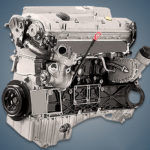The last largest civilian in-line six-cylinder Mercedes M104 E32 engine (excluding the sports M104 E34 AMG and M104 E36 AMG) appeared in 1991 and was developed on the basis of the three-liter M104 E30.
The R6-family includes: M103 E26, M103 E30, M104 E28, M104 E30, M104 E32, M256 E30.
The main difference between the M104 E30 and the M104 E32 is the cylinder block, in which a crankshaft with a piston stroke increased to 84 mm was placed, and the cylinder diameter was increased to 89.9 mm. Cylinder head from M104 E30, with 4 valves per cylinder. Fuel injection system – distributed injection. Starting in 1992, an intake manifold with variable geometry began to be installed on the M104 E32.
Instead of a single-row unreliable timing chain on the 103rd engine, the new M104 uses a double-row one, with a much longer service life.
Specifications
| Production years | 1991-1998 |
| Displacement, cc | 3199 |
| Fuel system | injector |
| Power output, hp | 220 – 230 |
| Torque output, Nm | 310 – 315 |
| Cylinder block | cast iron R6 |
| Block head | aluminum 24v |
| Cylinder bore, mm | 89.9 |
| Piston stroke, mm | 84 |
| Compression ratio | 9.2 – 10.0 |
| Features | no |
| Hydraulic lifters | yes |
| Timing drive | chain |
| Phase regulator | at the intake |
| Turbocharging | no |
| Recommended engine oil | 5W-40 |
| Engine oil capacity, liter | 7.0 |
| Fuel type | petrol |
| Euro standards | EURO 1/2 |
| Fuel consumption, L/100 km (for Mercedes E320 1994) — city — highway — combined |
14.7 8.2 11.0 |
| Engine lifespan, km | ~500 000 |
| Weight, kg | 195 |
Disadvantages of the M104 E32 engine
- The main problem of power units of this series is numerous oil leaks.
- First of all, gaskets leak: U-shaped, cylinder head and oil filter heat exchanger.
- The viscous coupling of the fan often fails, which is very dangerous for the engine.
- This motor is very afraid of overheating, the cylinder head is bent almost immediately.
- You will get a lot of trouble under the hood wiring, as well as ignition coils.






